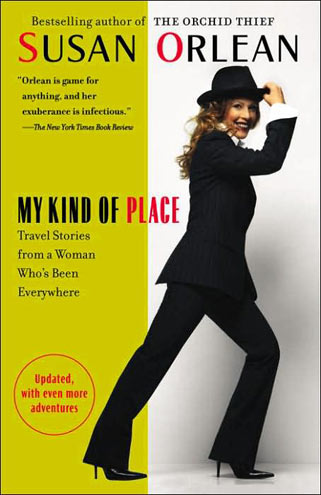 In the introduction to My Kind of Place, Susan Orlean confesses that she loves to travel – even to places that don’t sound wonderful. When the collection of essays begins with a taxidermy convention in Springfield, Illinois, it is immediately apparent that she means it.
In the introduction to My Kind of Place, Susan Orlean confesses that she loves to travel – even to places that don’t sound wonderful. When the collection of essays begins with a taxidermy convention in Springfield, Illinois, it is immediately apparent that she means it.
Susan Orlean
Like most of the world, I first came to Orlean’s work with the Orchid Thief. Unlike most of the world, I was a graduate student in Urban Horticulture when I read her dramatic portrayal of the curious underground world of illicit flowers. What I took from the book was the seed of a new life. The Orchid Thief was my first introduction to narrative nonfiction, my first glimpse of a style of writing of which I believed myself capable. It was possible to write long stories about interesting things, and normal people might read them.
As a writer obsessed with all things Icelandic, Iceland Writers Retreat was bound to catch my eye. But it was Susan Orlean’s name on the list of featured authors that pushed me to sign up. Which is how I came to be reading My Kind of Place: Travel Stories from a Woman Who’s Been Everywhere in preparation for my first writers’ retreat.
Writing Style
I am fascinated by the strange balance of Orlean’s language. It is formal enough for the New Yorker yet frank enough for Jezebel (which she does not, to my knowledge, write for). But what I like best about her writing is the way she makes herself almost transparent in the story. Her narratives are genuine first-person; there is no pretension of objectivity and she is fairly open about her prejudices. Orlean can reveal a subject to be a redneck or a wingnut without ever calling them such. But even when skewering her subjects with their own direct quotes, Orlean never allows the focus to shift from her subject onto herself.
Besides choice quotations, Orlean’s version of “show, don’t tell” involves lots of lists. She includes seemingly irrelevant details, like the list of items in a shopper’s basket; or a list of artificial body parts available for sale at a taxidermy convention; the breakfast menu at a hotel near a health spa. Somehow these trivial-seeming lists actually tell the story.
My Kind of Place
In the first section, titled “Here,” Orlean travels from Midwestern taxidermy to GW Bush’s home town in the South. She is there to cover child beauty pageants. These are followed by several stories set in New Jersey and the unfashionable boroughs of New York.
A cluster of stories about Cuba introduce the second section of My Kind of Place, “There,” which deals with the sort of places that mean “travel” to me – Europe, Bhutan, Australia, Japan, and Thailand. I appreciated Orlean’s leveraging of a single trip into multiple stories. The word counts range from “blog post” to “New Yorker feature.” I wish I had noticed the Author’s Note listing the original dates and publication of each story. The context of dates as I was reading would have been useful.
In the final section, called “Everywhere,” Orlean’s travels are less geographic. These short, bloggy pieces cover shower curtains, house guests, trailer park life, and Skymall –
the land of products I never think I want, serving needs I never thought I had, and which I can’t quite bring myself to buy but can’t help considering once they have been brought to my attention.
She also wrote a picture book that I stumbled on in the children’s section at the library only a few weeks ago about why babies don’t hold down jobs.
Orlean in Iceland
Almost at the end of My Kind of Place, there is a story about Keiko, the “Free Willy” whale, and Orlean’s trip to Iceland to learn about his freedom.
The final piece is a short reverie on a four leaf clover found in an inherited dictionary. It’s the only place where the tone becomes philosophical. Elsewhere she is wryly observant, like an Icelander waiting for a tourist to say something stupid. But like the Icelander, Orlean is open-minded, taking the good with the bad. The Afterword reveals her compassion for the subjects she shines her often unflattering spotlight on.
It is not surprising that the death of the freed whale Keiko saddens her. But she seems to also mourn the loss of the Cuban restaurant in Miami and the coat of corporate polish on a neighborhood grocery store. She revisits places with the same nostalgic sorrow as the backpacker who discovers a fancy hotel where the old hostel used to be. It is clear that Orlean brings genuine wonder to every place she covers, and misses them when they’re gone. As she says in the introduction, she goes
out to see what I can see and tell it as best I can
and that makes Susan Orlean my kind of writer.





About the author